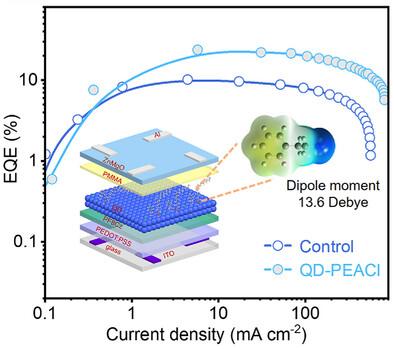高性能发光二极管用蓝量子点的偶极配体修饰
IF 19
1区 材料科学
Q1 CHEMISTRY, MULTIDISCIPLINARY
引用次数: 0
摘要
量子点(QD)发光二极管(qled)的电致发光性能已经有了显著的提高,以满足下一代显示商业化的先决条件。然而,与红色和绿色qled相比,蓝色qled的设备性能仍然低于标准。蓝色量子点的深能级导致了较差的孔注入能力。此外,核壳之间的小势垒有助于蓝色量子点中的载流子与量子点表面的硫悬空键耦合。本文引入偶极子分子苯乙基氯化铵(PEACl)修饰蓝色量子点的表面。长链油酸配体被Cl-离子取代改善了载流子的运输,而PEACl的NH3+基团钝化了表面硫缺陷。此外,PEACl的大偶极矩提高了能级,从而提高了器件中的空穴注入效率。因此,基于peacl修饰的ZnCdSe/ZnCdS/ZnS量子点的器件表现出创纪录的23.8%的外部量子效率,峰值亮度为42,724 cd m−2,外推的工作寿命为22180 h,在100 cd m−2下显着优于控制器件。这项工作为提高先进显示应用中蓝色qled的效率和稳定性提供了一种有前途的方法。本文章由计算机程序翻译,如有差异,请以英文原文为准。

Dipole Ligands Modification of Blue Quantum Dots for High-Performance Light-Emitting Diodes
The electroluminescence of quantum dot (QD) light-emitting diodes (QLEDs) has undergone significant enhancement to fulfil the prerequisites for commercialization in next-generation display. Nevertheless, the blue QLEDs still suffer from subpar device performance compared to red and green counterparts. The deep energy level of blue QDs leads to inferior hole injection capability. Additionally, the small potential barrier between the core and shell facilitates carrier in blue QDs coupling with sulfur dangling bonds on the QD surface. Herein, phenethylammonium chloride (PEACl), a dipole molecule, is introduced to modify the surface of blue QDs. The replacement of long-chain oleic acid ligands with Cl- ions improves carrier transport, while the NH3+ group of PEACl passivates surface sulfur defects. Additionally, the large dipole moment of PEACl upshifts the energy levels, thereby enhancing hole injection efficiency in the devices. Consequently, the resulting devices based on PEACl-modified ZnCdSe/ZnCdS/ZnS QDs exhibit a record external quantum efficiency of 23.8%, a peak luminance of 42,724 cd m−2, and an extrapolated operational lifetime of 22,180 h at 100 cd m−2, significantly outperforming the control devices. This work offers a promising approach to enhance the efficiency and stability of blue QLEDs for advanced display applications.
求助全文
通过发布文献求助,成功后即可免费获取论文全文。
去求助
来源期刊

Advanced Functional Materials
工程技术-材料科学:综合
CiteScore
29.50
自引率
4.20%
发文量
2086
审稿时长
2.1 months
期刊介绍:
Firmly established as a top-tier materials science journal, Advanced Functional Materials reports breakthrough research in all aspects of materials science, including nanotechnology, chemistry, physics, and biology every week.
Advanced Functional Materials is known for its rapid and fair peer review, quality content, and high impact, making it the first choice of the international materials science community.
 求助内容:
求助内容: 应助结果提醒方式:
应助结果提醒方式:


